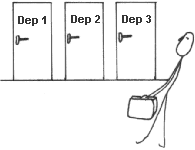Difficult to succeed with Intranets
By Kaisa Solman, November 2003
Over and over again we hear tales of ineffective intranets. Most criticism generally concerns navigation and structure – users find it slow and cumbersome to find the information (or functionality) that they need in their work.
One common source of problems is information and functionality being organised based on what part of the organisation is responsible for it, rather than how users want to use it...

A typical problem: End users looking for a certain type of course must must remember which department gives the course – only that department's “sub-site” has the information.
Succeeding with an intranet isn’t easy – those responsible face various significant challenges, several of which are discussed briefly below:
Huge volume of content to present and update – often by many people
The amount of material available through an intranet in a large organisation is often overwhelming. Matters are made worse by the fact that individual departments naturally want to prioritise the visibility of their own information, which can distract design focus away from the needs of users who want to overview information that might “belong” to several departments. Furthermore, those people responsible for creating content often do so in different ways as common guidance doesn’t exist or isn’t followed (e.g. even simple aspects such as page titles and summaries which might provide some aid to users who resort to using search functions).
Lack of good reference examples
Whilst web site designers can find inspiration on the Internet, those working with an intranet usually lack access to others. They must rely on their own imagination and/or what results by “default” from using their selected intranet publication tool. Matters are not helped by the fact that design guidelines, if such exist, often focus more on “branding” (font type, colour usage, logo placement) than layout for efficient and effective use.
The need for user-centred activities isn’t understood
When one is creating a product for colleagues within an organisation then one can think that it should be possible to imagine what users might want, and how they might want it. Thus whilst the need to involve end-users in the design of “external” products (e.g. a public web site) might be understood, the importance of a similar approach with intranet users is not seen, despite the availability of users. The value of end-user involvement for “internal” products and systems should not be underestimated – huge amounts of time (and hence money) can be wasted through users being unable to find information or being unable to use key functions efficiently.
However, it is possible to succeed with intranets – there are some good ones! Jakob Nielsen (link to Alertbox oct 13 2003) recently presented the top 10 intranets of 2003. Many belong to big organisations that have understood the value of investing in the usability of their intranets, given the potential productivity gains with such a large number of users. However, several of those mentioned belong to smaller organisations who have succeeded with somewhat more limited resources..
It is particularly worth noting that (quoting directly from Jakob Nielsen’s article): “Intranets are changing from being document repositories to being work support tools. Many of this year's winners had changed their information architecture (IA) from one determined by how documents are produced (usually the company's department structure) to one determined by users' tasks.”
Unfortunately no Intranets belonging to Scandinavian organisations appeared in Jakob Nielsen’s list this year. However, if you’re working with an Intranet for a Scandinavian organisation and feel that it is particularly usable then we’d love to hear from you!
Related articles:
- Nielsens 'Alertbox' article about the top intranets of 2003
- Intranet Web - new interface challenges (Usability Partners, 2001:10)
Did you find this editorial interesting?
You might like to read some of our other editorials.
Please send us an email if you have any comments or suggestions!